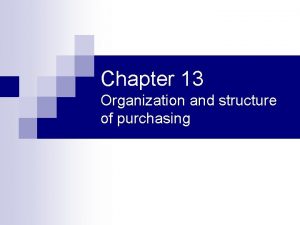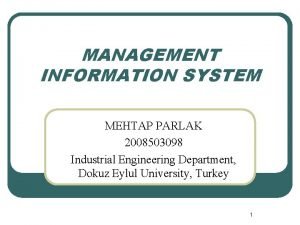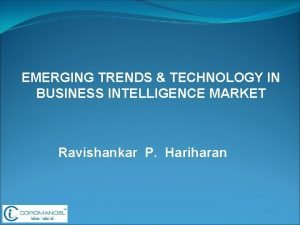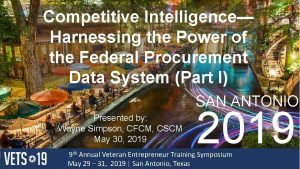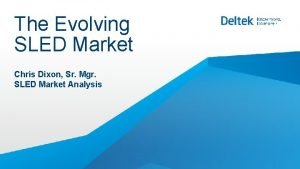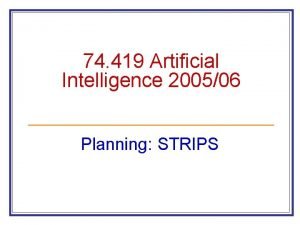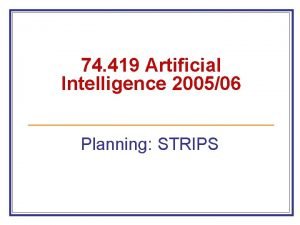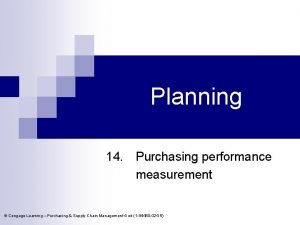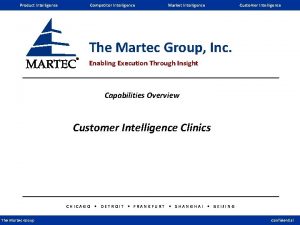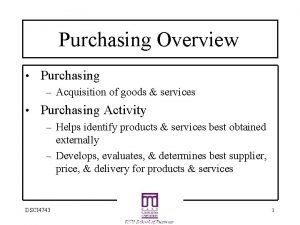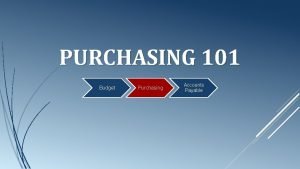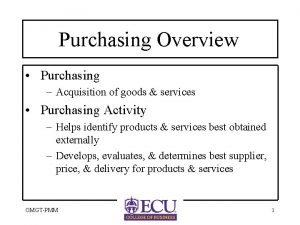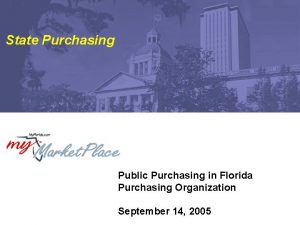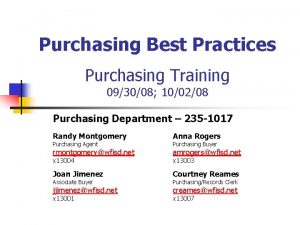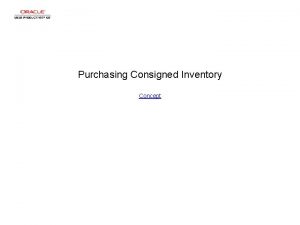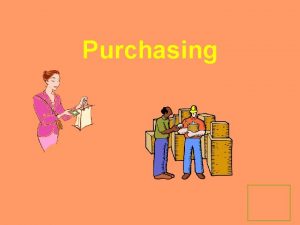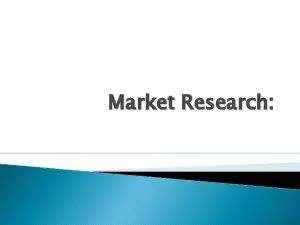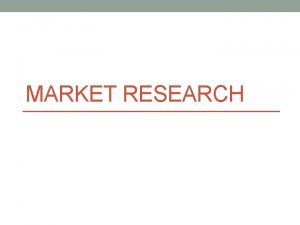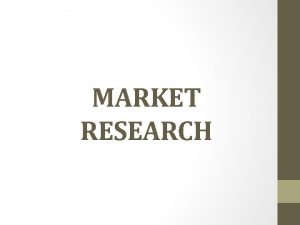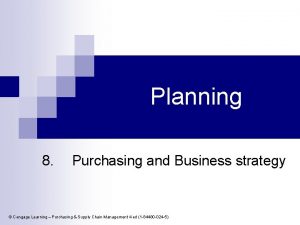Planning 6 Purchasing Intelligence and market research Cengage















- Slides: 15

Planning 6. Purchasing Intelligence and market research © Cengage Learning – Purchasing & Supply Chain Management 4 ed (1 -84480 -024 -5)

Program n n n Why purchasing market research? Purchasing market research: definition How to structure purchasing market research Subjects of purchasing market research Purchasing market research and information technology Organizing for purchasing market research © Cengage Learning – Purchasing & Supply Chain Management 4 ed (1 -84480 -024 -5)

Why purchasing market research? n Continuing technological developments: Should a company develop new technologies itself or buy them? n Supply market dynamics: International supply and demand are constantly changing due to changes in business cycles, mergers and acquisitions etc. . n Changes in European economies: Changes in international labour costs and productivity may lead to different sourcing patterns by large companies. n Monetary developments: High inflation in some countries, large governmental budget deficits, rapidly changing currency exchange rates may require action from buyers © Cengage Learning – Purchasing & Supply Chain Management 4 ed (1 -84480 -024 -5)

Purchasing market research: definition Fearon (1976) defines purchasing market research as: Systematic gathering, classifying and analyzing data considering all relevant factors that influence the procurement of goods and services for the purpose of meeting present and future company requirements in such a way that they contribute to an optimal return. © Cengage Learning – Purchasing & Supply Chain Management 4 ed (1 -84480 -024 -5)

How to structure market research 1. Determine objectives What exactly is the problem to be solved? What information is desired? How accurate does the information have to be? 2. Cost-benefits analysis What will be the costs of the research? How many hours are required? 3. Feasibility study What information is already available? The next step is only taken when the required information is unavailable in the form of publications or statistics. © Cengage Learning – Purchasing & Supply Chain Management 4 ed (1 -84480 -024 -5)

How to structure market research 4. Design of research plan Specific action is sometimes needed to obtain information, e. g. auditing a supplier. A detailed project plan is needed to prepare for research. 5. Execution of research activities In this stage it is important to follow the project plan prepared earlier. 6. Preparing research report and evaluation When the research is finished a report has to be prepared- this has to contain the assignment, as well as the obtained results. © Cengage Learning – Purchasing & Supply Chain Management 4 ed (1 -84480 -024 -5)

How to structure market research Evaluation Determine objectives Prepare research re Cost-benefit analysis A stepwise approach Data analysis Feasibility study What? Desk research Data collection Execution of research activities Design of research activities Where? © Cengage Learning – Purchasing & Supply Chain Management 4 ed (1 -84480 -024 -5) Field research

How to structure market research Desk research versus Field research: Desk research: the gathering, analysis and interpretation of data that serve the research assignment, but which have already been gathered by others (e. g. internet search). Field research: the gathering, analysis and interpretation of information that cannot be obtained by desk research. It tries to track down new information: visits to industrial exhibitions and suppliers are examples of field research methods © Cengage Learning – Purchasing & Supply Chain Management 4 ed (1 -84480 -024 -5)

How to structure market research Some of the most important e-marketplaces listed per industry n Automotive ¨ ¨ n Aviation ¨ ¨ ¨ n www. aeroxchange. com www. b 2 b-aero. com www. exostar. com Building and construction ¨ ¨ ¨ n www. covisint. com www. supplyon. com www. bravobuild. it www. edilportale. it www. citadon. com Chemicals ¨ ¨ n Healthcare and Pharmaceutical ¨ n Retail and consumer goods ¨ ¨ n www. gnx. com www. wwre. com Transportation and Logistics ¨ n www. ghx. com www. transcore. com Energy and fuels www. eutilia. com ¨ www. traderanger. com ¨ n www. elemica. com www. chemconnect. com This list was taken from e-market services (2003). The e-market places may have undergone Significant changes since then. © Cengage Learning – Purchasing & Supply Chain Management 4 ed (1 -84480 -024 -5) Food and beverage www. transcore. com ¨ www. cpgmarket. com ¨

Subjects of purchasing market research Fearon (1976) distinguishes 3 areas of investigation: n Materials, goods and services: aims at realizing savings or at reducing purchasing related costs n Suppliers: is concerned with obtaining specific information with regard to the supplier’s financial performance, capabilities, management, processes, systems. n Systems and procedures: a good purchasing information system is of great importance. ICT offers great possibilities but it has to be guided on the basis of buyer’s needs. © Cengage Learning – Purchasing & Supply Chain Management 4 ed (1 -84480 -024 -5)

Subjects of purchasing market research Another distinction: n Macro-economic research: refers to the general economic environment and focuses on factors that can influence the future balance between supply and demand. n Meso-economic research: focuses on specific sectors of industry. n Micro-economic research: focuses on assessing strengths and weaknesses of individual suppliers and products. © Cengage Learning – Purchasing & Supply Chain Management 4 ed (1 -84480 -024 -5)

Three areas of purchasing market research. Macro-economic research Meso-economic research Micro-economic research BASF Ford Europe Steel Chrysl Shell er Bayer. GM Automotive e. g. Chemical industry US US Japan © Cengage Learning – Purchasing & Supply Chain Management 4 ed (1 -84480 -024 -5) adapted from Fae and de Weerd, 19

Main parameters to be addressed in purchasing market research Level Parameter Macroeconomics n Business cycle and economic growth n Development of industrial production n Average utilization rate in industry n Mesoeconomics n Supply-and-demand analysis n Utilization rate n Order situation and sales n Microeconomics n Financial situation organizational structure n Quality of delivered goods n Delivery performance n © Cengage Learning – Purchasing & Supply Chain Management 4 ed (1 -84480 -024 -5) Price development n Interest rate n Development of wages n Productivity development n Political climate Inventories n Market structure Delivery lead time n General conditions n Service quality n Ownership and shares n Cost-price structure n Price level

Purchasing market research and information technology Companies are discovering the many ways in which ICT may support their purchasing operations and strategies. Some examples: n n Company’s like Grasso, manufacturer of industrial cooling and heating equipment and part of a large German group with business units around the world, have installed a purchasing intranet within three months enabling exchange of product, supplier and contract information Data suppliers like Yellow Pages, ABC have now available through their websites vast supplier bases covering supplier addresses in all major EC countries enabling buyers to conduct market surveys in short time. Sony uses its Purchasing website to attract new suppliers for certain commodities. Companies like Fed. Ex, DHL, UPS provide linkages through the Internet which enable companies to keep track of their deliveries. © Cengage Learning – Purchasing & Supply Chain Management 4 ed (1 -84480 -024 -5)

Introduction of purchasing market research Fearon 1976 mentions 3 methods of establishing purchasing market research: 1. Create a staff department Locate all purchasing market research activities in a separate department or section. Advantage: research can be allocated to specialist researcher. 2. Market research conducted by the buyer Advantages: research only done on issues which buyers consider relevant and this enlarges their involvement Disadvantages: buyer’s lack of time to do the research systematically and the lack of knowledge of market research techniques. 3. Work with research teams Compromise solution: ad hoc research teams consisting of buyers and researchers. © Cengage Learning – Purchasing & Supply Chain Management 4 ed (1 -84480 -024 -5)
 Centralized purchasing and decentralized purchasing
Centralized purchasing and decentralized purchasing Emergency purchase
Emergency purchase Segmenting targeting and positioning
Segmenting targeting and positioning Word module 2 creating a research paper
Word module 2 creating a research paper Market leader follower challenger nicher
Market leader follower challenger nicher Sequence and series cengage
Sequence and series cengage Determinant of a coefficient matrix
Determinant of a coefficient matrix Cengage anatomy and physiology
Cengage anatomy and physiology Market intelligence system
Market intelligence system Emerging trends in business intelligence
Emerging trends in business intelligence Federal competitive intelligence
Federal competitive intelligence Sled market intelligence
Sled market intelligence Mobile business intelligence market
Mobile business intelligence market Sled market segment
Sled market segment Strips planning example
Strips planning example Strips planning
Strips planning
